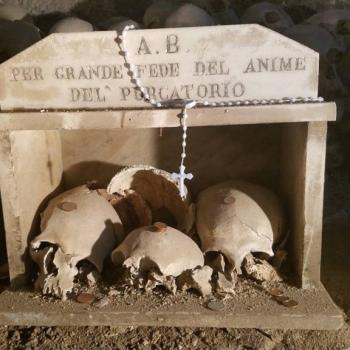By Guest Contributor Judika Illes*
Can’t find your purse? Lost your keys? You’ve misplaced something crucial. You know it’s around here somewhere, but you can’t find it. Who can help you? Saint Anthony, that’s who.
Among the most beloved of all saints, Anthony of Padua celebrates his feast on June 13, smack in the heart of Gemini season, the zodiac sign symbolized by twins, and so perhaps it is appropriate that Anthony is a saint possessing a dual nature. There are two sides to Saint Anthony, the official and the unofficial, the sacred and the profane, Doctor of the Church and witch doctor saint.
The historical and well-documented future Saint Anthony was born Fernando Martins de Bulhœs (sometimes spelled de Buillon) in Lisbon, Portugal, on August 15, 1195, the scion of an aristocratic family. Devout from an early age – legend says that his first word was “Maria” – he soon rejected his family’s wealth and status. By age fifteen, he had dedicated himself to Christ. Anthony joined the Franciscans, which was then a new order. Later, yearning to be a missionary, he traveled to Morocco, but fell very ill there. Attempting to return home to Portugal, he found himself shipwrecked in Italy instead.
Anthony lived in a cave for a while, as a solitary hermit, venturing out only to attend Mass and to sweep a nearby monastery, where the resident monks soon took notice of the charismatic and learned young man. When a scheduled speaker failed to appear, the monks persuaded Anthony to preach instead. His eloquence was electrifying. How eloquent was he? Legend says that even fish emerged from the sea to hear him speak!
Fluent in several languages, Anthony began preaching throughout France and Italy. Miracles were attributed to him while he was still alive. Extremely beloved, even though he reputedly had a quick-witted, sharp tongue, Anthony was canonized less than a year after his death on June 13, 1231. The speed with which he was canonized is believed to reflect the speed with which Anthony fulfills devotees’ requests.
Anthony of Padua is the patron saint of travelers, sailors, those who seek to conceive, those who work with spices, the oppressed, the hungry, and the elderly. It’s difficult to envision the historical Anthony, a strict, severe man, responding to requests to find missing purses. One imagines he would have a sharp retort to anyone who dared to ask.
And yet, Saint Anthony is loved for his helpfulness, tolerance, and good nature. Mysterious, powerful, and friendly, Anthony is renowned for helping everyone, regardless of religious affiliation, sexual orientation, or behavior that the historical man most certainly would have condemned, such as witchcraft practices. Anthony has long been invoked by Italy’s stregas (witches), as well as by magical practitioners of all persuasions. As is the case with Saint Jude, Patron of Lost Causes, statues that portray Anthony blessing with his left hand, rather than the customary right hand, indicate his willingness to engage in sorcery or to protect magical practitioners or so goes the legend.
Famously, Anthony is the finding saint. If something is missing or lost, Anthony can find it. Provided that your request can be phrased in terms of ‘finding,’ Anthony can help. Invoked daily to find simple, concrete objects — wallets, documents, or rings, for example – Anthony is also requested to provide more complex needs and desires. What is missing from your life? Anthony finds employment, employees, true love, sobriety, missing persons and pets, medical diagnoses, organ donors, and virtually anything a devotee requires or craves.
No need for elaborate rituals, Anthony’s assistance is invoked with a little rhyme:
Tony, Tony, look around!
Something’s lost and must be found!
Variations of this rhyme exist and may be regional. I learned this version in New York City and New Jersey, where perhaps we speak informally (but affectionately) with saints. I’ve since been reprimanded by those (especially from the Philadelphia area), who say that he should be addressed formally as Saint Anthony. However, Tony, himself, has never seemed to object.
Follow the rhyme with a more detailed and personal request: “Please Saint Anthony, I need you to find my [wedding ring, wallet, or whatever it is].” Deadlines may be incorporated. (“Saint Anthony, I need you to find my driver’s license by Friday,” for example). It’s also customary to promise him an offering, should your request be fulfilled. Anthony is reputedly fond of candles, white Calla lilies, and charitable donations on behalf of hungry people or the welfare of domestic animals.
What if Anthony fails to find what you need? That depends upon the one seeking his aid. Most will simply let it go, accepting their fate, but historically aggressive action has been taken against the saint, essentially attempting to force him into action. Although this seems cruel to do to such a loving saint, it is an ancient practice that requires a statue of the saint.
The statue may be placed upside down in the back of a dark closet, until Anthony delivers what’s missing. Others seek to shame the saint publicly by hanging his statue upside down out in the open, so that all may witness his failure to act. Alternatively, some kidnap Anthony’s baby. Virtually all Saint Anthony imagery features him holding a baby. Originally intended to represent the Christ Child, based on a visionary incident in the historical Anthony’s life, it is obvious to anyone viewing his iconography that Anthony loves the baby in his arms. Some Anthony statues are designed with removable babies. Should Anthony fail to materialize the requested item, the baby is removed and withheld until the saint delivers, essentially held for ransom.
Why such contradictory behavior? Many scholars believe it indicates syncretism–the presence of a second, secret, forbidden spirit hiding beneath the mask of the respectable saint. As I write in my book, Encyclopedia of Mystics, Saints, and Sages (HarperOne, 2011), “Syncretism is the process by which two or more sacred beings fuse, as forbidden spirits masquerade under the guise of those that are authorized.”
In other words, when a sacred being, such as a saint, doesn’t behave in an expected manner, it may indicate the shadow of another. Devotees maintain forbidden spiritual relationships by venerating the acceptable in their stead. After several generations, however, knowledge of the suppressed being may be forgotten. Only the practice remains. Many believe that the subversive aspects of Saint Anthony may indicate the lingering presence of ancient deities Hermes or Mercury. Alternatively, a now unknown Italian spirit may lurk beneath the saint’s mask. Syncretism is an on-going process and in recent centuries, images of Anthony have been used to represent African Diaspora spirits such as Ogun and the equally eloquent Elegua.
*Judika Illes is the author of numerous books including Encyclopedia of Mystics, Saints, and Sages and Encyclopedia of 5000 Spells. Find her on Facebook.












